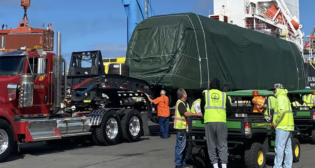
NTSB, TSB issue joint CBR safety recommendations
Written by William C. Vantuono, Editor-in-ChiefNoting that crude oil shipments by rail have increased by more than 400% since 2005, according to the Association of American Railroads’ Annual Report of Hazardous Materials, NTSB and TSB issued three recommendations to FRA and PHMSA. The first would require expanded hazardous materials route planning for railroads to avoid populated and other sensitive areas. The second is to develop an audit program to ensure that railroads moving petroleum products have adequate response capabilities to address worst-case discharges of the entire quantity of product carried on a train. The third is to audit shippers and railroads to ensure that they are properly classifying hazardous materials in transportation and that they have adequate safety and security plans in place.
The recommendations are contained in NTSB Safety Recommendation Letters R-14-001-003 and R-14-004-006.
NTSB has investigated several accidents involving flammable liquids transported in DOT-111 tank cars. Among these are a Dec. 30, 2013, derailment in Casselton, N.Dak., and a June 19, 2009 derailment in Cherry Valley, Ill. After the Cherry Valley accident, NTSB issued several safety recommendations to PHMSA regarding what it says is “the inadequate design and poor performance of DOT-111 tank cars.” The recommendations included making the tank head and shell more puncture resistant and requiring that bottom outlet valves remain closed during accidents. NTSB noted that “although PHMSA initiated a rulemaking to address the safety issue, it has not issued any new rules.”
North American tank car builders did not wait for a rulemaking from either PHMSA or FRA to manufacture stronger tank cars. Since October 2011, all DOT 111 tank cars have been built with stronger steel, head shields, shelf couplers, and bottom outlet valves that are far less prone to opening in a derailment. The AAR has called upon FRA and PHMSA to issue a rulemaking to improve upon these standards and also begin the phase-out or retrofitting of older DOT 111 cars.
“The NTSB is concerned that major loss of life, property damage, and environmental consequences can occur when large volumes of crude oil or other flammable liquids are transported on a single train involved in an accident, as seen in the Lac Megantic, Quebec, accident, as well as several accidents the NTSB has investigated in the U.S.,” said NTSB Chairman Deborah A.P. Hersman. “The large-scale shipment of crude oil by rail simply didn’t exist ten years ago, and our safety regulations need to catch up with this new reality. While this energy boom is good for business, the people and the environment along rail corridors must be protected from harm. If unit trains of flammable liquids are going to be part of our nation’s energy future, we need to make sure the hazardous materials classification is accurate, the route is well planned, and the tank cars are as robust as possible.”



